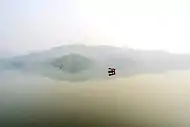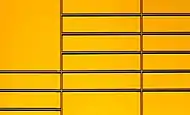Minimalist photography
Minimalist photography is a form of photography that is distinguished by extreme, austere simplicity.[1] It emphasizes spareness and focuses solely on the smallest number of objects in the composition process.
.jpg.webp)
Etymology

.jpeg.webp)
Minimalist photography arises from the notion of minimalism in art, which is a style used by many 20th century artists. This style emphasizes the use of a minimal number of compositional elements: color, objects, shapes and texture.[2] The aim of minimalist photography is to express a concept, in order to bring forth a distinctive visual experience or elicit an emotional response from the viewer. In the world of photography, it is viewed as an exceptionally intuitive and personal concept, entrusting interpretation and understanding to the audience perspective of the art .
History
.jpg.webp)
Minimalist photography stems from its initial art movement; minimalism, which was a movement in the 1950s that emerged in the United States, also known as Minimalist Art, Reductive Art or ABC Art. As the name denotes, minimalism — which originates from the word minimum — means the slightest or the littlest amount required.[3] In the art world, minimalism employs a limited amount of elements to construct the desired effect. Generally speaking, the most crucial characteristic of this style is its ultimate simplicity, impartial and neutral approach. For example, an artist utilizing minimalism will normally use a restricted quantity of colors coupled with a simplified subject matter in the construction of the artwork. Artists focus on the idea of simplicity and plainness in their creations and the resulting movement has been a great source of inspiration for other artists in the following decades .
Technique
Minimalism as an art movement first originated in the 1950s. It is also known as Reductive Art, ABC Art and Minimalist Art. This movement eliminates its objects to the smallest amount of colors, shapes, and textures in order to establish a needed effect. Reducing color, lines and form to a minimum amount in its composition is the main goal of minimalist artists. The most important characteristics of this art movement include; simplicity (where no excessive subject matters are utilized), repetitions (where artists employ repetitive colors and lines in the artworks), geometric shapes (where rectangles and circles are often employed in the painting to convey a sense of simpleness and coherence). Other important characteristics include using very little materials, props and other symbols in the creation of the composition.[4] For example, black and white images are a representation of the minimalist style as color is being reduced to minimize distractions. Minimalism as a concept in arts can be dated back to the 1900s. Influences of minimalism are still employed today in diverse fields such as photography, design, sculpture and architecture.
Photography
Minimalist photography focuses on simplicity and its artistic style can be encapsulated by the quote, "less is more." Minimalist photographers achieve this effect by casting aside all the unnecessary components in creating their works.[5] This principle is demonstrated in various minimalist photographs, for example, when capturing a mountain or an ocean on camera, the entirety of the scenery will be presented as one big vast space. The vacancy and bareness of the space shown enables the audience to imagine and craft their own version of interpretation and comprehension, instead of including the photographer's own inputs and insights. In order to expand and concentrate on the expansive space, it is crucial to minimize contradicting elements such as people or distracting buildings. Doing so conveys a sense of barrenness and desolation that creates a theatrical atmosphere and visual experience. Therefore, a minimalist photograph is often captured early in the morning, sunrise or dark at night. This ensures that the scene is not filled with crowds and that the overall composition appears neat and simplified.
Minimalist Photography
"As an approach in photography, minimalism or minimalistic photography could be taken by the photographer in all genres. No matter your are a portrait, architecture, landscape etc. photographer, minimalist photos are always an option as long as you have a minimal look toward your surroundings" -Milad Safabakhsh, Founder of Minimalist Photography Awards.
Minimalist photography often pays attention to one single subject in its composition, using nature as its background. Some representative subject matters include geometric patterns, lines and textures, which can range between an apple, a mountain or a bridge, to name a few examples. Although this style of photography is derived from the art movement in the early 1950s, its impact is exhibited in various forms of digital photography.
Gallery
- Minimalist photography
 Early morning at Begnas lake presented in minimalist approach
Early morning at Begnas lake presented in minimalist approach Yellow boxes
Yellow boxes Lake
Lake
References
- Philippines, Digital Photography, 2010, ‘TECHNIQUE Minimalist Magic’, Minimalist Magic, 20 Oct. 2010, pp. 062–067.
- VanEenoo, Cedric, 2011, ‘Minimalism in Art and Design: Concept, influences, implications and perspectives’, Journal of Fine and Studio Art, vol. 2(1), pp. 7-12.
- Jovanovic Srdjan, 2009, ‘Hedonism in Abstract Art: Minimalist Digital Abstract Photography’, Rupkatha Journal on Interdisciplinary Studies in Humanities, vol. 1, pp. 88-91.
- Inan, Sukriye, 2014, ‘The effects of minimalist movement on painting arts and music’, University Department of Fine Art, vol. 5, pp. 11-22.
- Tuck, Kirk, 2008, Minimalist Lighting, Professional Techniques for Location Photography, Amherst Media, New York.
See also
| Wikimedia Commons has media related to Commons:Featured pictures/Places/Natural. |